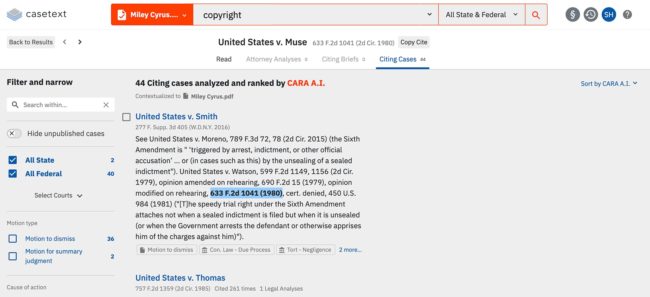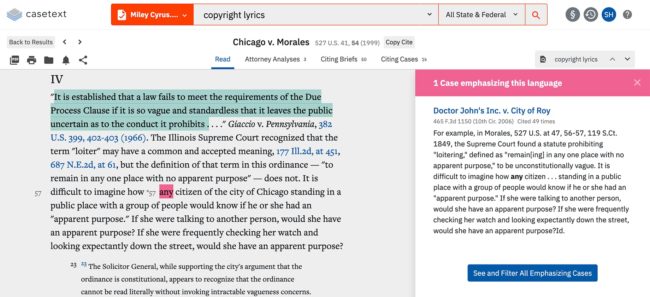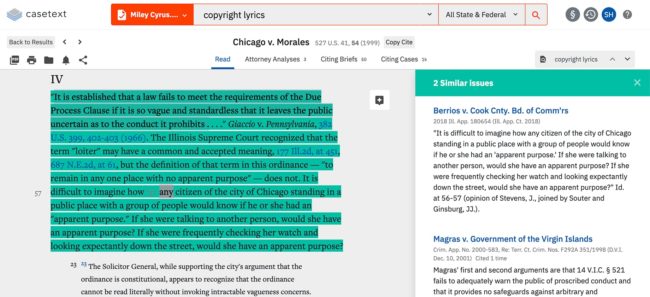
Knowing whether a case is good law is elemental to legal research. To do this, lawyers have long relied on citator services such as Shepard’s from LexisNexis and KeyCite from Westlaw. Now, the legal research service Casetext has introduced a citator of its own, called SmartCite, with many of the features you would expect to find in a citator, plus some that make it unique.
Pablo Arredondo, cofounder and chief product officer at Casetext, says that SmartCite is an umbrella name for a number of new features, some common to citators and some new and unique.
Let’s start with those colored flags researchers know so well. Like other citators, SmartCite shows red flags for bad law, green flags for good law, and yellow flags when there may be reason for caution. SmartCite also has orange flags for cases that rely on overruled cases. Orange flags are not found in Shepard’s and were introduced in KeyCite only with last year’s launch of Westlaw Edge.
Another unique feature of SmartCite is its integration with Casetext’s CARA artificial intelligence search. CARA was originally launched as a brief-analysis tool. But last year, Casetext integrated CARA into the standard legal research workflow, as I explained here, meaning that you can upload case documents such as pleadings and memoranda and CARA will analyze those to tailor your legal research results to cases that are more relevant to your facts and issues.

CARA can be used to refine the list of citing cases.
With SmartCite, Casetext extends that capability to the citator. By using CARA with your citation check, the list of citing cases will be ranked according to your factual and legal context. This is particularly helpful when there are hundreds of citing cases. Rather than wade through them all, you can upload a document through CARA to refine and prioritize the results to what you’re looking for.
Separate from CARA, SmartCite also includes a variety of filters to allow you to narrow lists of citing cases. These filters allow you to narrow results by type of motion decided in the case (e.g., motion to dismiss or to compel discovery), by type of party involved (retail, government, etc.), and by cause of action at issue in the citing case.
SmartCite makes clever use of what judges tell us when they cite cases. To determine which cases to tag with a yellow flag, SmartCite looks for when a case has been cited using one of the contrary citation signals, “but see,” “but cf.” and “contra.”
Judges, when they cite a case, have to make a decision about how to cite it, Arredondo points out. When they use one of these contrary citation signals, they are telling us, “I’m citing this because it’s at odds with what I just said.”

Another “signal” SmartCite looks for from judges is the phrase “emphasis added.” SmartCite uses this signal to label passages in cited cases. First, it highlight in green passages in cited cases that have been quoted extensively. Then, it highlights in pink any words or phrase for which a judge added emphasis.
“Judges do us a favor,” Arredondo explains. “They tell us, ‘I’m going to emphasize the words in this quote that really matter.’ So when reading a case on Casetext, green means the passage has been quoted a lot, but pink means there was emphasis added there.”
SmartCite also draws on what judges tell us in another way. As you review the list of citing cases, you see excerpts from each case. Within each excerpt is bold text that provides a concise summary of how the citing case referenced the original case. These highlights are extracted directly from what the judge wrote in the citing case, generally in a parenthetical explaining why the case was being cited.

Another new feature is what Casetext calls Similar Issue. As you are reading any paragraph in a case, you can click an icon next to the paragraph and see other paragraphs from other cases that discuss the same topic, whether or not they are cited in the case you are reading. The net effect, Arredondo says, is to turn any paragraph into a headnote.
Early in its development, Casetext experimented with a crowdsourced citator. While that was a clever way to build a citation service, SmartCite gives Casetext a citator that seems to be more on par with the kind of thoroughness and accuracy lawyers would expect. And by combining SmartCite with CARA and giving it features not found in other citators, Casetext has given an original spin to what a citator can be.
If you have never tried Casetext, I suggest you do. There is a 14-day free trial available, after which a monthly subscription is $65 for a solo, with lower pricing for multiple attorneys.
Editor’s Note: This article republished with permission of the author, from this blog LawSites.
